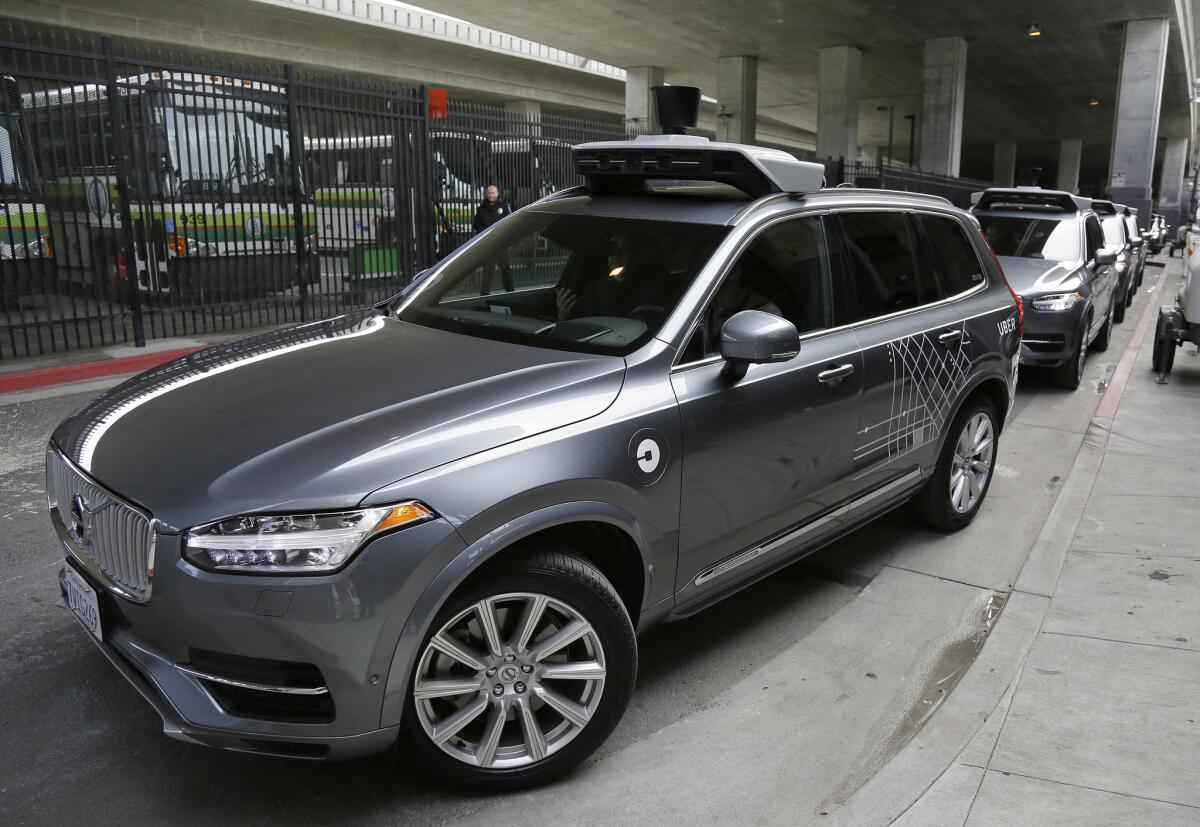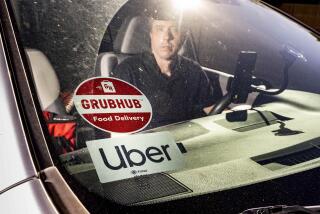Uber’s self-driving cars put tech’s ‘move fast, break things’ credo to the test

- Share via
Reporting from San Francisco — Uber became the dominant ride-hailing company in the U.S. by operating under the principle that it’s better to ask for forgiveness than permission.
In city after city, the San Francisco company launched without first consulting local regulators, often in violation of rules governing taxi companies. As it grew popular, statewide bans were nearly always overturned and legislation crafted to legalize app-based ride-hailing services, helping Uber roll out in more than 45 states.
For the record:
7:21 p.m. July 11, 2025A previous version of this article identified Steve Beck as co-founder of the management consultancy cg42. Beck is the sole founder.
Now, as Uber ventures into self-driving cars — with the long-term goal of having fleets of vehicles that don’t require a driver behind the wheel — it appears to be embracing the same aggressive tactics. But what worked in Uber’s war on taxis may not work in its war on drivers, according to technology and transportation analysts, who say regulators may prove less willing to cave now that the company is pushing technology that the public doesn’t yet trust.
On Wednesday, the California Department of Motor Vehicles went after the ride-hailing giant, issuing a strongly worded letter demanding that Uber cease its self-driving car program in San Francisco or face legal action. The program — which uses Volvos equipped with self-driving technology but has a driver behind the wheel in case of emergency — launched in the city earlier that day. To complicate matters, one of the vehicles was caught on video running a red light (Uber blamed the incident on the error of its human driver).
“Had Uber obtained [a permit for testing autonomous vehicles] prior to today, the company’s launch would have been permissible,” Brian Soublet, the DMV’s deputy director and chief counsel said in a letter addressed to Anthony Levandowski, the head of Uber’s Advanced Technology center. “However, it is illegal for the company to operate its self-driving vehicles on public roads until it receives an autonomous testing permit.”
Uber had not responded to the DMV’s letter as of Thursday afternoon, a DMV spokesman said, and the company did not immediately respond to The Times’ multiple requests for comment. But on Uber’s website, Levandowski said he didn’t believe that the company needed permits, arguing that it was still “early days, and our cars are not yet ready to drive without a person monitoring them.”
Media reports suggest that the vehicles remained on the road after the DMV sent its letter.
This attitude is typical of Uber, according to analysts, who noted that the company’s familiar strategy of acting before asking — common among technology companies such as Facebook that pride themselves on “moving fast and breaking things” — may face greater opposition in its push for self-driving cars than its upheaval of the taxi industry.
Otto, a self-driving truck company that Uber acquired in August for $680 million, also landed in hot water with the Nevada DMV this year. The firm, which was founded by Levandowski, released a promotional video that appeared to show one of its trucks rolling down a highway without a person behind the wheel. Backchannel reported that the company did so even after the Nevada DMV issued a warning that it would be violating the state’s autonomous vehicle regulations.
“Uber has a history of playing pretty fast and loose with the rules,” said Steve Beck, founder of business strategy firm cg42, which advises companies on ways to comply with regulation. “But that’s not a strategy that works in this context because the stakes are really high.”
Unlike app-based ride-hailing, which consumers quickly warmed to because it met a desperate need in many cities for a more convenient and widely available alternative to taxis and limos, self-driving cars have not yet won in the court of public opinion.
When companies are developing new technologies, it’s incumbent on them to win over the public’s trust, Beck said. And when it comes to self-driving cars, that trust simply is not there yet.
“As a corporate citizen, this is a mistake for Uber,” Beck said. “The stakes can literally be as high as life and death, and they’re going to be seen as a company that’s cutting corners. It’s not a sound strategy.”
At the heart of the DMV’s cease-and-desist order is state legislation that requires anyone testing autonomous vehicles on the state’s roadways to apply for a permit. The permit costs $150 and requires holders to send reports to the state on crashes and on “disengagement” — the times when the autonomous system turns off and hands control back to the driver.
Without a permit, Uber would not have to report such information. Permit holders in California include Tesla, Google, Honda, Ford, Mercedes-Benz and 15 other companies.
Uber might have a plausible legal argument, based on the text of the legislation, said Bryant Walker Smith, a law professor at the University of South Carolina and a specialist in autonomous vehicle law. But the intent of the law, he said, is “in large part about building trust, and Uber is not building any trust in its systems or practices by doing this.”
The federal Department of Transportation this year issued proposed guidelines for autonomous vehicle development, explicitly stating that it believes the technology will lead to safer roads. Individual states, however, determine which vehicles can travel on their roads. Politicians and regulators are trying to balance life-saving innovation with protection of the public given the emerging technology’s limited track record.
Like all other states that have passed autonomous driving regulations, California defines “autonomous technology” as having the “capability” to drive a vehicle with no human intervention. Uber claims that its cars are not autonomous and that there is always a driver inside. But it does call the cars “self-driving.” If the company is not being disingenuous, it is “over-claiming” the capabilities, Smith said. “A human is turning the steering wheel.”
Or, as Evan Rawley, a professor at Columbia Business School, put it, “They want the cars to be considered self-driving by the investment community and human-driven by the regulatory community.”
Uber, which has been customizing Volvos and Fords into self-driving cars, has been running a similar program in Pittsburgh since September. Asked to comment, a Ford spokeswoman said by email, “We share the DMV’s goal and intend to continue working with them to ensure safe operation of autonomous vehicles on roads.”
At Volvo, which unlike Ford is a formal partner with Uber, a spokesman made clear that Volvo is providing specially fitted cars to accommodate Uber’s own self-driving technology, so meeting legal and permit requirements is Uber’s responsibility. But, he added, “As for Uber’s approach to automated driving, we’re comfortable.”
But even if Uber wins its battle with the DMV, this particular tiff might hurt its standing with the public more than past regulatory battles, analysts said. Part of it comes back to the inherent distrust the public has of computer-driven cars. But incidents such as the self-driving car running a red light on Wednesday could entrench people’s fears and skepticism about the technology, said Rebecca Lindland, a senior analyst at Kelley Blue Book.
“This was supposed to be the safest of all simulations, having a driver in the car, and yet we had a compromise on safety,” Lindland said. “They have to play well with others. Uber needs to make the case for why San Francisco is a good place to conduct these tests, and that they’re not compromising on the safety of the community.
Some analysts speculated about whether Uber Chief Executive Travis Kalanick joining president-elect Donald Trump’s business advisory council might help the company with its regulatory hurdles. But this seems unlikely, given that transportation is heavily regulated at a local level, and Trump has in the past expressed a desire to leave much decision-making in the hands of states.
That leaves Uber to play ball with local authorities. Or not. The company had in recent years shown an interest in softening its image with regulators and the broader community, launching initiatives to sign up more veterans as drivers, throwing its support behind California’s Proposition 47 (which reduces certain felonies to misdemeanors) to give more people an chance to drive for the service and partnering with Mothers Against Drink Driving.
But its latest feud with the DMV suggests that the company isn’t ready to grow up yet, Beck said.
“Maybe they’re in those awkward teen years where you start to make good decisions, but you still slip up,” he said. “That’s why you need parents.”
Lien and Mitchell reported from San Francisco and Etehad from Los Angeles.
Twitter: @traceylien
russ.mitchell@latimes.com
melissa.etehad@latimes.com









